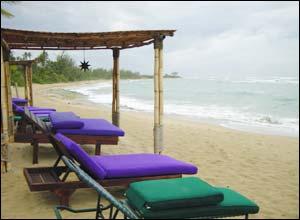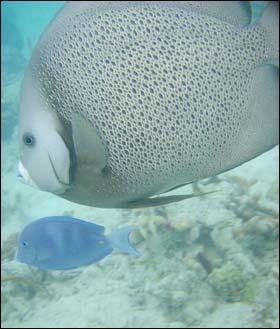|
 |
|
Esta página no está disponible en español. THE MIAMI HERALD 'Door To The Sun' Opens Up Fantastic Deep-Sea Ops On Puerto Rico's west coast, there's a place where surfers worship the endless waves and divers are treated to pristine waters and untouched reefs. BY LORRY HEVERLY 21 November 2004
If divers want to experience the undiscovered side of Puerto Rico, far from the hustle and bustle of San Juan, they head west, to a place where life is simple and beauty abounds in spectacular sunsets and drop dead beaches. Dubbed the Porta del Sol or ''door to the sun,'' the island's west coast sports dramatic stretches of coastline, hideaway fishing villages and is a natural for the watersports set. SHORE DIVES Spanning the north west point of the island, Aguadilla is not only known for its world class surfing but is also dubbed the ''garden of the Atlantic,'' an underwater garden that is. Shore dives rules here and Captain Jose Rafols of Aquatica Dive & Bike Adventures showed me one of his favorite sites at Crash Boat Beach. A cluster of red and yellow fishing boats was gathered on the palm tree lined beach. There was just a handful of locals, a family on a beach picnic and a group of teenagers catching some rays. Friendly folks who waved as we suited up in scuba gear and waded into the surf. Our mission was to seek out marine life lurking under the pier. Crash Boat Beach is a series of piers and platforms in 30 feet of water, a short swim from shore, perfect for beginner divers or a night dive. The shady pier, with pylons covered in orange cup corals and delicate sponges, is home to an odd assortment of juvenile fish, crabs, porcupine fish, moray eels, flying gurnards and schools of goatfish. Isabela Caverns, off a rocky stretch of a surfer's hangout known as Shack's, is a beach entry dive through an underwater ring of rocks and caverns. The caverns are only diveable at certain times of the day, depending on the tides. Natural light dances through jagged holes in the top of the reef, lighting the way for divers to navigate through a maze of submerged chambers and winding passageways.
UNINHABITED ISLES The West Coast's signature dives are around the offshore islands of Desecheo and Mona. Home to brown boobies and monkeys, Desecheo is a protected National Wildlife Refuge, 13 miles off the northern west coast. The island's colorful south side features an underwater garden of vibrant corals ranging from giant lavender sea fans to a rainbow of sponges and bubbly brain corals. Along the north coast are pinnacles, tunnels, and steep drop offs, with visibility exceeding 100 feet. Known as the ''Galapagos of the Caribbean,'' Mona Island lies 40 miles off the mainland. It's worth the long boat ride across rough waters of Mona Passage for this exceptional blue water experience. Mona boasts more than 270 species of fish and large marine creatures including sharks, rays, sea turtles, dolphin and whales (January to late March). Crystal clear waters offer visibility of more than 200 feet. Coral reefs, caverns and vertical walls ring the island, with sites for all levels of divers. Trips include overnight camping with oversized iguanas and sea turtles nesting on white sand beaches. WALLS THAT WOW Divers flock to La Parguera, a small fishing village on the tip of the southwest coast, to dive a variety of awesome sites along the 20-mile long Parguera Wall. Parguera Divers run daily boat trips to more than 25 different sites from the dock of the family-run inn, Posada Porlamar. As we cruised through a picturesque channel of mangrove islands and cays, the seas became somewhat choppy once we hit the open ocean. The best months for calm seas, says Captain Angel Rovira of Parguera Divers, are late December to March, with winds picking up again in the summer. Cloaked in an abundance of lush black corals, Black Wall begins in 55 feet making a dramatic sheer drop to 200 feet. Here, divers are usually adopted by schools of black durgons that follow them through the dive. Turtles and other creatures of the deep play among a diversity of giant gorgonians, multicolored corals, undulating sea fans on Efra's Wall. A hands-down favorite is Fallen Rock, which begins as a wall until divers come to a giant boulder surrounded by trenches, filled with hordes of colorful tropical fishes. La Parguera is also home to the nearby bioluminescent bay, best seen on moonless nights. Here, a ghostly green glow is produced in the water as millions of dinoflagellates emit tiny flashes of light when disturbed. Another topside diversion is kayaking in the Boqueron Forest mangroves. This quaint coastal village is quiet midweek, but is a popular getaway for island families on the weekends. DIVING INFORMATION Villa Montaña Beach Resort, Isabela: Casually elegant hotel rooms and villas in a tropical garden setting on 30 acres of secluded beachfront. 888-780-9195, www.villa montana.net. Aquatica Dive & Bike Adventures, Ramey Base, Aguadilla: Full-service dive shop with guided shore diving, boat trips and charters to Desecheo Island. 787-890-6071, www.aquatica.cjb.net. Posada Porlamar, Lajas: A family-run boutique hotel on the waterfront. 787-899- 4015, www.parguerapuertorico.com. Parguera Divers, Lajas: Offers daily two-tank boat dives. Dive packages begin at $302 per diver, double occupancy for three nights at the Posada, and four dives. 787-899-4171, www.parguera divers.com. Puerto Rico Tourism Company: www.gotopuertorico.com, 800-866-7827.
|

 ----------
---------- ----------
----------